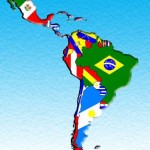NACLA Reports on the Role of Latin America in the “New Global Capitalism”
 In the introduction to the North American Congress on Latin America’s summer report on the Americas, William I. Robinson discusses the current role of Latin America in what has over the past two decades become an increasingly globalized world economy. Writes Robinson of the “Walmartization” of Latin America, “the new face of global capitalism is everywhere in Latin America, from the ubiquitous fast-food chains, malls, and superstores that dominate local markets in emerging megacities to vast new fields of soy run by transnational agribusiness, which has invaded the Southern Cone countryside…” He goes on to assert that, “whole neighborhoods have been built with remittance wages sent by the tens of millions of Latin American emigrants who provide cheap itinerant labor for other regions in the global economy.” The exploitative practices of big corporations like these is a hard pill to swallow, and have severely influenced the shape of Latin America’s economy, with export processing zones (or maquiladoras) becoming the prime symbol for global capitalism. While the new global capitalism in Latin America has paved the way for sizable modernization (which obviously has questionable benefits in and of itself), Williams also argues that it has changed Latin America in ways that exaggerate over consumption and poverty:
In the introduction to the North American Congress on Latin America’s summer report on the Americas, William I. Robinson discusses the current role of Latin America in what has over the past two decades become an increasingly globalized world economy. Writes Robinson of the “Walmartization” of Latin America, “the new face of global capitalism is everywhere in Latin America, from the ubiquitous fast-food chains, malls, and superstores that dominate local markets in emerging megacities to vast new fields of soy run by transnational agribusiness, which has invaded the Southern Cone countryside…” He goes on to assert that, “whole neighborhoods have been built with remittance wages sent by the tens of millions of Latin American emigrants who provide cheap itinerant labor for other regions in the global economy.” The exploitative practices of big corporations like these is a hard pill to swallow, and have severely influenced the shape of Latin America’s economy, with export processing zones (or maquiladoras) becoming the prime symbol for global capitalism. While the new global capitalism in Latin America has paved the way for sizable modernization (which obviously has questionable benefits in and of itself), Williams also argues that it has changed Latin America in ways that exaggerate over consumption and poverty:
It has transformed the old oligarchic class structures, generating new transnationally oriented elites and high-consumption middle classes that enjoy the fruits of the global economic cornucopia even as it has displaced tens of millions, aggravated poverty and inequality in many countries, and wreaked havoc on the environment.
In the bulk of the article, Williams distills Latin America’s political economy and its place in the world economy over the past 30 years into six “dynamic activities.” These activities are as follows:
(1) The reorientation of industry towards global markets with “national industrial activity integrated into global production chains as component phases of the Global Factory.
(2) “New transnational agribusiness exports have increasingly eclipsed the old agro-export and domestic agricultural models.”
(3) “The growth of the global tourist industry has exploded over the last two decades.”
(4) The transnationalization of services, commerce, and finance.
(5) The importance of the exportation of labor from Latin America in the global economy.
(6) “A new round of extractive activity has been launched, including a vast expansion of mining operations and energy extraction to feed a voracious global economy, especially in the Asia-Pacific region…”
Click here for the entire article.












